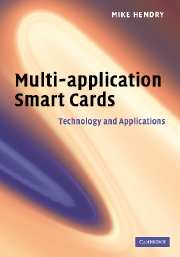Book contents
- Frontmatter
- Contents
- Foreword by Kevin Gillick
- Acknowledgements
- Part I Introduction
- Part II Technology
- 4 Biometrics
- 5 Security and cryptography
- 6 Card technology
- 7 Readers and terminals
- 8 Application selection: the ISO 7816 family
- 9 JavaCard and GlobalPlatform
- 10 Multos
- 11 Other operating systems
- 12 Card management systems
- Part III Business requirements
- Part IV Implementation
- Appendix A Glossary
- Appendix B Further reading
- Appendix C Standards
- Index
- References
11 - Other operating systems
from Part II - Technology
Published online by Cambridge University Press: 11 August 2009
- Frontmatter
- Contents
- Foreword by Kevin Gillick
- Acknowledgements
- Part I Introduction
- Part II Technology
- 4 Biometrics
- 5 Security and cryptography
- 6 Card technology
- 7 Readers and terminals
- 8 Application selection: the ISO 7816 family
- 9 JavaCard and GlobalPlatform
- 10 Multos
- 11 Other operating systems
- 12 Card management systems
- Part III Business requirements
- Part IV Implementation
- Appendix A Glossary
- Appendix B Further reading
- Appendix C Standards
- Index
- References
Summary
Every smart-card vendor has its implementation of the ISO 7816 file structure and application selection process: these form the vendor's native operating system and, as we have seen in Chapter 6, they can be used to create a multi-application card scheme.
To gain the full benefits of portability, a high-level language and post-issuance downloading of applications, you need a multi-application operating system like JavaCard or Multos. But there are several operating systems that sit between these two extremes, and which may offer advantages in some situations.
IBM MFC
IBM developed its first multi-function card (MFC) 1 in the early 1990s. It has since been developed to extend the cryptographic support and add new features. One of its most important features, however, is the ability to support applications in E2PROM, which can be updated or downloaded after the initial issuance, using a scripting protocol.
IBM stopped supplying smart cards directly in 1999, but it has licensed the MFC to several manufacturers, and also develops tailored versions for specific schemes. It is now used by the French multi-application payment and e-purse card Monéo 2.
Advantis
Spanish card technology and systems supplier SERMEPA developed its ‘TIBC’ operating system in 1994 in order to run the ‘Visa Cash’ electronic purse product; TIBC was licensed to several card manufacturers and is still widely used in Spain and Latin America.
- Type
- Chapter
- Information
- Multi-application Smart CardsTechnology and Applications, pp. 98 - 103Publisher: Cambridge University PressPrint publication year: 2007



